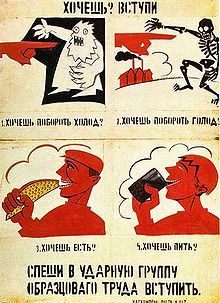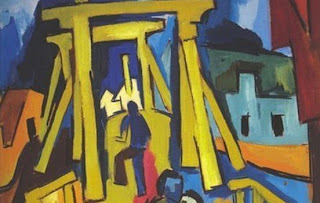Futurism was an artistic and social movement that originated in Italy in the early 20th century.
-It emphasized and glorified themes associated with contemporary concepts of the future, including speed, technology, youth and violence, and objects such as the car, the airplane and the industrial city. It was largely an Italian phenomenon, though there were parallel movements in Russia, England and elsewhere.
-The Futurists practiced in every medium of art, including painting, sculpture, ceramics, graphic design, industrial design, interior design, theatre, film, fashion, textiles, literature, music, architecture and even gastronomy.
-The founder of Futurism and its most influential personality was the Italian writer Filippo Tommaso Marinetti
-Marinetti launched the movement in his Futurist Manifesto, which he published for the first time on 5 February 1909 in La gazzetta dell'Emilia, an article then reproduced in the French daily newspaper Le Figaro on 20 February 1909. He was soon joined by the painters Umberto Boccioni, Carlo Carrà, Giacomo Balla, Gino Severini and the composer Luigi Russolo.
-The Futurist painters were slow to develop a distinctive style and subject matter. In 1910 and 1911 they used the techniques of Divisionism, breaking light and color down into a field of stippled dots and stripes, which had been originally created by Giovanni Segantini and others.
-The Futurist architect Antonio Sant'Elia expressed his ideas of modernity in his drawings for La Città Nuova (The New City) (1912–1914). This project was never built and Sant'Elia was killed in the First World War, but his ideas influenced later generations of architects and artists.
- This project was never built and Sant'Elia was killed in the First World War, but his ideas influenced later generations of architects and artists.
-Russian Futurism was a movement of literature and the visual arts. The poet Vladimir Mayakovsky was a prominent member of the movement. Visual artists such as David Burlyuk, Mikhail Larionov, Natalia Goncharova and Kazimir Malevich found inspiration in the imagery of Futurist writings and were poets themselves.
-Futurist music rejected tradition and introduced experimental sounds inspired by machinery, and would influence several 20th century composers.
-Futurism as a literary movement made its official debut with F.T. Marinetti's Manifesto of Futurism (1909), as it delineated the various ideals Futurist poetry should strive for.
Giacomo Balla
Umberto Boccioni
An example of futurustic architecture:
25 Mayıs 2012 Cuma
22 Mayıs 2012 Salı
CONSTRUCTIVISM
-Constructivism was an artistic and architectural philosophy that originated in Russia beginning in 1919, which was a rejection of the idea of autonomous art.
-The movement was in favour of art as a practice for social purposes.
- Constructivism had a great effect on modern art movements of the 20th century, influencing major trends such as Bauhaus and the De Stijl movement
-Its influence was pervasive, with major impacts upon architecture, graphic and industrial design, theatre, film, dance, fashion and to some extent music.
-The term Construction Art was first used as a derisive term by Kazimir Malevich to describe the work of Alexander Rodchenko in 1917.
-Constructivism as theory and practice was derived largely from a series of debates at INKhUK (Institute of Artistic Culture) in Moscow, from 1920–22.
-As much as involving itself in designs for industry, the Constructivists worked on public festivals and street designs for the post-October revolution Bolshevik government.
-The movement was in favour of art as a practice for social purposes.
- Constructivism had a great effect on modern art movements of the 20th century, influencing major trends such as Bauhaus and the De Stijl movement
-Its influence was pervasive, with major impacts upon architecture, graphic and industrial design, theatre, film, dance, fashion and to some extent music.
-The term Construction Art was first used as a derisive term by Kazimir Malevich to describe the work of Alexander Rodchenko in 1917.
-Constructivism as theory and practice was derived largely from a series of debates at INKhUK (Institute of Artistic Culture) in Moscow, from 1920–22.
-As much as involving itself in designs for industry, the Constructivists worked on public festivals and street designs for the post-October revolution Bolshevik government.
19 Mayıs 2012 Cumartesi
CUBISM
-Cubism is an early 20th century avant-garde art movement pioneered by Pablo Picasso and George Braque that revolutionized European painting and sculpture, and inspired related movements in music,
-Cubism has been considered the most influential art movement of the 20th-century.
- A primary influence that led to Cubism stems from the representation of three-dimensional form produced during the late 1900s by Paul Cézanne, following a retrospective at the 1907 Salon d’Automne
-In Cubist artworks, objects are analyzed, broken up and re-assembled in an abstracted form—instead of depicting objects from one viewpoint, the artist depicts the subject from a multitude of viewpoints to represent the subject in a greater context.
-The beginnings of Cubism have been dated between 1907 and 1911.
-The first organized group exhibition by Cubists took place at the Salon des Indépendants in Paris during the spring of 1911 in a room called ‘Salle 41’; it included works by Jean Metzinger, Albert Gleizes, Fernand Léger, Robert Delaunay and Henri Le Fauconnier, yet no works by Picasso and Braque were exhibited.
-During the late 19th and early 20th centuries, the European cultural elite were discovering African, Micronesian and Native American art for the first time. Artists such as Paul Gauguin, Henri Matisse, and Pablo Picasso were intrigued and inspired by the stark power and simplicity of styles of those foreign cultures.
Paul Cezanne
Pablo Picasso
Geoerges Braque
-Cubism has been considered the most influential art movement of the 20th-century.
- A primary influence that led to Cubism stems from the representation of three-dimensional form produced during the late 1900s by Paul Cézanne, following a retrospective at the 1907 Salon d’Automne
-In Cubist artworks, objects are analyzed, broken up and re-assembled in an abstracted form—instead of depicting objects from one viewpoint, the artist depicts the subject from a multitude of viewpoints to represent the subject in a greater context.
-The beginnings of Cubism have been dated between 1907 and 1911.
-The first organized group exhibition by Cubists took place at the Salon des Indépendants in Paris during the spring of 1911 in a room called ‘Salle 41’; it included works by Jean Metzinger, Albert Gleizes, Fernand Léger, Robert Delaunay and Henri Le Fauconnier, yet no works by Picasso and Braque were exhibited.
-During the late 19th and early 20th centuries, the European cultural elite were discovering African, Micronesian and Native American art for the first time. Artists such as Paul Gauguin, Henri Matisse, and Pablo Picasso were intrigued and inspired by the stark power and simplicity of styles of those foreign cultures.
Paul Cezanne
Pablo Picasso
Geoerges Braque
17 Mayıs 2012 Perşembe
DİE BRÜCKE
-Die Brücke (The Bridge) was a group of German expressionist artists formed in Dresden in 1905, after which the Brücke Museum in Berlin was named.
-Founding members were Fritz Bleyl, Erich Heckel, Ernst Ludwig Kirchner and Karl Schmidt-Rottluff. Later members were Emil Nolde, Max Pechstein and Otto Mueller. The seminal group had a major impact on the evolution of modern art in the 20th century and the creation of expressionism
-The founding members of Die Brücke in 1905 were four Jugendstil architecture students: Fritz Bleyl (1880–1966), Erich Heckel (1883–1970), Ernst Ludwig Kirchner (1880–1938) and Karl Schmidt-Rottluff (1884–1976).
-Die Brücke aimed to eschew the prevalent traditional academic style and find a new mode of artistic expression, which would form a bridge (hence the name) between the past and the present
The group members initially "isolated" themselves in a working-class neighborhood of Dresden, aiming thereby to reject their own bourgeois backgrounds.
-The group published a broadside called Programme in 1906, where Kirchner wrote:
We call all young people together, and as young people, who carry the future in us, we want to wrest freedom for our actions and our lives from the older, comfortably established forces
Some samples are:

-Founding members were Fritz Bleyl, Erich Heckel, Ernst Ludwig Kirchner and Karl Schmidt-Rottluff. Later members were Emil Nolde, Max Pechstein and Otto Mueller. The seminal group had a major impact on the evolution of modern art in the 20th century and the creation of expressionism
-The founding members of Die Brücke in 1905 were four Jugendstil architecture students: Fritz Bleyl (1880–1966), Erich Heckel (1883–1970), Ernst Ludwig Kirchner (1880–1938) and Karl Schmidt-Rottluff (1884–1976).
-Die Brücke aimed to eschew the prevalent traditional academic style and find a new mode of artistic expression, which would form a bridge (hence the name) between the past and the present
The group members initially "isolated" themselves in a working-class neighborhood of Dresden, aiming thereby to reject their own bourgeois backgrounds.
-The group published a broadside called Programme in 1906, where Kirchner wrote:
We call all young people together, and as young people, who carry the future in us, we want to wrest freedom for our actions and our lives from the older, comfortably established forces
Some samples are:

Kaydol:
Yorumlar (Atom)








